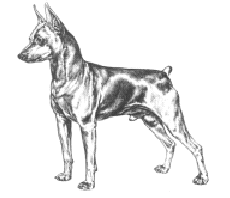Miniature Pinscher
General Information - Miniature Pinscher

Group:
Toy
Size:
Small
Lifespan:
12-14 years
Exercise:
Little
Grooming:
Very low
Trainability:
Very hard
Watchdog Ability:
Very high
Protection Ability:
Very low
Area of Origin:
Germany
Date of Origin:
1600s
Other Names:
Reh Pinscher, Zwergpinscher
Original Function:
Small-vermin hunting
History
The Miniature Pinscher is not related to the Doberman Pinscher, and is in fact an older breed than the Doberman. Developed in Germany from terrier breeds, including the German Pinscher, the Miniature Pinscher's original use was in hunting rats to keep the population down in the stables that it frequented. Italian Greyhound blood may have been added to produce such a tiny, high stepping-dog. These little German spitfires were developed into a distinct breed, the Reh Pinscher in the early 1800s, so named because of their resemblance to the small red German roe (reh) deer. The word Pinscher means terrier in German. Today the Min Pin's high spirit and bright personality make him a charming companion. Some of the Miniature Pinscher's talents are competitive obedience, watchdogging, and agility.
Temperament
The Miniature Pinscher is one of the most energetic breeds. Playful and brave, the Miniature Pinscher is described as a "big dog in a little dog's body." Min Pins may be aggressive, but they are generally good with children and other house pets.
Upkeep
The Min Pin needs lots of activity. Because of its small size, its exercise needs can be met indoors or out; regardless, it needs several play sessions every day. It enjoys a romp outdoors in a safe area, but it hates the cold. This is not a breed to live outdoors. Its coat is virtually carefree, requiring only occasional brushing to remove dead hair.
Miniature Pinscher
A breed standard is the guideline which describes the ideal characteristics, temperament, and appearance of a breed and ensures that the breed is fit for function with soundness essential. Breeders and judges should at all times be careful to avoid obvious conditions and exaggerations, as well as being mindful of features which could be detrimental in any way to the health, welfare or soundness of this breed.
Breed Standard - Miniature Pinscher
 General Appearance:
General Appearance: The Miniature Pinscher is structurally a well balanced, sturdy, compact, elegant, short-coupled, smooth-coated toy dog. He is naturally well groomed, proud, vigorous and alert. The natural characteristic traits which identify him from other toy dogs are his precise Hackney gait, his fearless animation, complete self:possession and his spirited presence.
Head and Skull: Rather more elongated than short and round. Narrow and without conspicuous cheek formation. In correct proportion to the body. The skull should appear flat when viewed from the front. The muzzle must be rather strong and proportionate to the skull. The nose well formed, black only with the exception of livers and blues, which may have a self-coloured nose.
Eyes: Fitting well into the face. Neither too full nor round, neither too little nor slanting. Black or nearly black.
Ears: Must be set on high, as small as possible, erect or dropped.
Mouth: Scissors bite.
Neck: Strong yet graceful. Slightly arched. Well fitted into the shoulders. Free from throatiness.
Forequarters: Forechest well developed and full, moderately broad, shoulders clean, sloping with moderate angulation. Coordinated to permit the true action of the Hackney pony.
Body: To be square, back line straight, sloping slightly towards the rear. Belly moderately tucked up. Ribs well sprung, deep rather than barrelled. Viewed from the top slightly wedge:shaped.
Hindquarters: Should be parallel to each other and wide enough apart to fit in with a properly built body. The hindquarters should be well developed and muscular with a good sweep of stifle and their hocks turning neither in nor out.
Feet: Legs straight, medium bone. Feet cat:like, elbows close to body. Nails dark.
Tail: A continuation of the top:line carried a little high and customarily docked short.
Coat: Smooth, hard and short. Straight and lustrous. Closely adhering to and uniformly covering the body.
Colour: Black, blue, chocolate with sharply defined tan markings on checks, lips, lower jaw, throat, twin spots above eyes and chest, lower half of fore-legs, inside of hind-legs and vent region, lower portion of hocks and feet. All the above colours should have black pencilling on toes with no thumb marks. Solid red of various shades. Slight white on chest is permissible but undesirable.
Height: The height is to range from 25.5 to 30.5 cm. (10:12 inches) at the withers.
Note: Male animals should have two apparently normal testicles fully descended into the scrotum.
DNZ No 144
Copyright Dogs New Zealand
19 Dec 2013
Any departure from the foregoing points should be considered a fault and the seriousness with which the fault should be regarded should be in exact proportion to its degree and its effect upon the health and welfare of the dog and on the dog’s ability to perform its traditional work.




